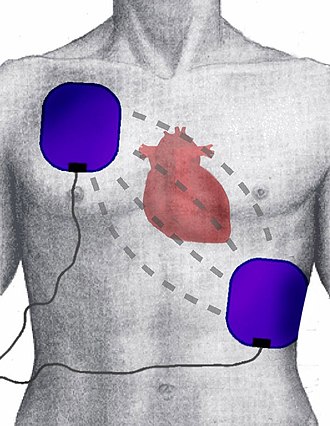Defibrillation and cardioversion
Ventricular fibrillation is an acute, life-threatening condition in which there are no regular effective contractions of the ventricular muscle, but only uncoordinated tremors. The heart stops working as a pump and the blood circulation slows to a halt. Defibrillation is the most effective therapy for ventricular fibrillation, ventricular tachycardia, atrial fibrillation and atrial flutter. The electric discharge depolarizes all myocardial cells at the same time and thus induces conditions for the application of physiological centers of excitation production and propagation.
The defibrillator electrodes are placed to the right of the stern just below the collarbone and to the left in the middle axillary line at the level of the nipple. The electrodes must be in perfect conductive contact with the skin during defibrillation, otherwise it will burn. After switching on the circuit, a discharge (capacitor discharge) occurs, which lasts 8 to 12 milliseconds.
Electrical cardioversion is indicated in atrial fibrillation or paroxysmal tachycardias in case of pharmacotherapy failure and persistent patient difficulties. Cardioversion requires less energy to cancel ventricular tachycardia, a 50-100 J shock is usually sufficient.
References[edit | edit source]
Related articles[edit | edit source]
source[edit | edit source]
- KYMPLOVÁ, Jaroslava. Catalog of methods in biophysics [online]. [feeling. 2012-09-20]. < https://portal.lf1.cuni.cz/clanek-793-katalog-metod-v-biofyzice >.
Category : Catalog of methods in biophysics
Biophysics
Cardiology


